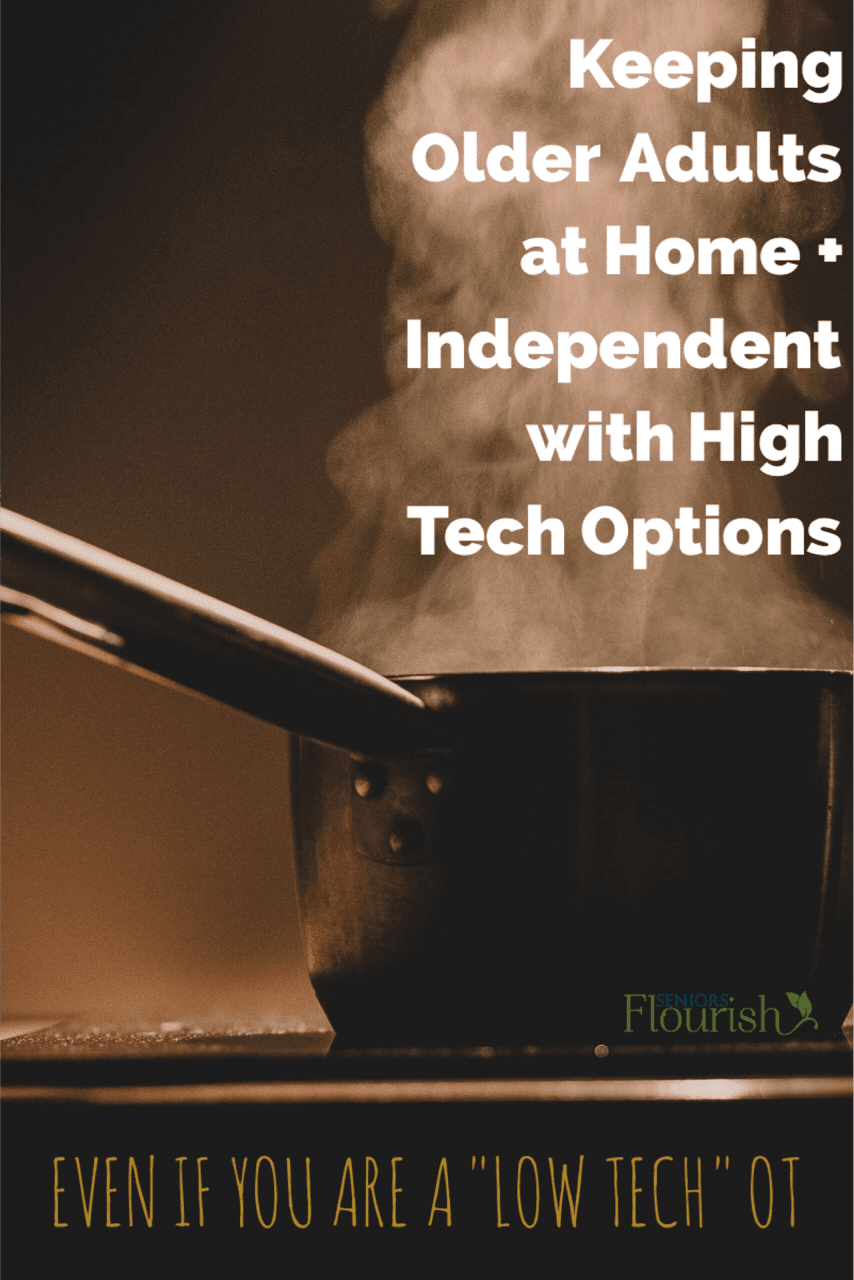I can honestly say I am a “jack of all trades” in the occupational therapy world. I am not an assistive technology guru or even have easy access to someone that is, since I live in a rural community. But I DO complete a lot of home assessments and make recommendations on home modifications for older adults.
I am going to review what to look for in matching a patient’s needs with equipment, as well as get some ideas flowing on high-tech home modification options, even if you are a “low-tech” OT.
So why do so many of us avoid high tech suggestions when we make recommendations for home modifications?
I know I did when I first started out in the world of OT. My first job was in home health (I know, I know, not ideal for a new grad 🙂 ) and I remember feeling that since I wasn’t confident in making good high tech recommendations, I didn’t want patient’s and families to spend the money on the equipment. So I avoided it.
Let’s dig into what all of this actually means, the differences in types of home modifications and get some examples.
What are examples of home modifications?
Home modifications are crucial for enhancing accessibility and safety in residences. Some common examples include installing ramps for wheelchair access, adding grab bars in bathrooms, widening doorways for easier navigation, incorporating non-slip flooring to prevent accidents, and creating roll-in showers for those with mobility challenges. Other modifications encompass accessible countertops, lever-style door handles, smart home technology, and even elevators or stair lifts for multi-story homes.
These modifications can significantly improve the quality of life for individuals with disabilities, older adults, or anyone facing mobility limitations, allowing them to maintain independence and live comfortably in their homes. In addition, home modifications can help the caregiver through reducing body pain from physical assistance, stress, responsibility and even caregiver burnout. Educating the caregiver on how these will help them personally, as well as these 3 other tips, will help with carryover of the home modifications in the home environment.
High-tech home accessibility modifications does not have to mean complicated or expensive (but it can!). It does not even have to mean using computer programs or software (that is why there are assistive technology specialists!). But what it does mean is using technology to promote independence.
What is the difference between high tech and tow tech home mods?
High-tech modifications offer advanced features and customization but can be expensive and require a learning curve. Low-tech modifications, on the other hand, are simple, cost-effective, and prioritize safety and accessibility without relying on advanced technology. The choice between the two depends on individual needs, preferences, and budget constraints.
What are the patient’s strengths and limitations?
- Best way to figure out needs is through a functional task analysis.
What types of equipment is the patient familiar with?
- Do they use a smart phone?
- Are they even interested in using high-tech options in the home environment?
One size does not fit all.
- What high tech options are there and what will work for them?
- Are they capable of new learning?
- Is the recommendation a good match cognitively?
Matching the patient’s needs with the appropriate equipment and home modifications (either high or low tech) is the ultimate goal for optimal independence and occupational performance.

Let’s Break Each of Them Down:
High-Tech Features:
- Incorporate Advanced Technology: High-tech modifications involve the integration of advanced technologies into the home environment. This can include automation, smart devices, and digital systems.
- Expensive: High-tech modifications tend to be more costly due to the expense of purchasing and installing advanced technology. Smart home devices, like automated lighting or voice-activated assistants, can add up quickly. But there are also programs, loans, organizations and veteran benefits out there to help our patients pay for some of these as well. Check out this entire blog post called, Where to Find FREE DME Supplies for OT Patients for some ideas
- Enhance Accessibility and Comfort: These modifications are designed to not only make the home more accessible but also to enhance overall comfort and convenience. For example, voice-activated lights and thermostats can be controlled without physical effort.
- Customization: High-tech solutions often allow for a high degree of customization to meet individual needs. Home automation systems can be tailored to specific preferences and can even anticipate user needs.
- Remote Monitoring and Control: Many high-tech modifications can be remotely monitored and controlled through smartphones or computers. This is particularly useful for individuals who may need assistance or supervision from caregivers or family members.
- Learning Curve: High-tech solutions may require some time and effort to learn and use effectively, especially for those who are not familiar with technology. However, they can provide a significant degree of independence once mastered.
Low-Tech Features:
- Simple and Affordable: Low-tech modifications are typically simple, cost-effective solutions that don’t rely on advanced technology. These can include non-slip mats, grab bars, or raised toilet seats.
- Accessibility and Safety: Low-tech modifications primarily focus on improving accessibility and safety within the home. They are practical and designed to reduce the risk of accidents and improve mobility.
- Ease of Installation: Most low-tech modifications can be installed relatively easily and quickly, often without the need for professional assistance. This makes them accessible to a wide range of individuals.
- No Learning Curve: These modifications usually require minimal to no learning curve. They are straightforward and intuitive, making them suitable for individuals of all ages and technological backgrounds.
- Limited Automation: Low-tech solutions do not offer the same level of automation or customization as high-tech options. They provide essential support but do not have the ability to adapt to changing needs or preferences.
- Reliability: Low-tech modifications are known for their reliability and durability. They are less prone to technical malfunctions or software glitches, making them a dependable choice.
Examples:
Hearing

Alarms that flash, are extra loud and even shake a bed to alert of a smoke detector going off.
Phones with extra large buttons, flashing lights, pictures for easy phone use.
Kitchen

Touchless faucet for difficulties with turning it on.

Automatically turns off stove when activated by sound of fire alarm as there is always smoke before fire.
Bathroom

TUSHY Classic 3.0 Bidet Toilet Seat Attachment

Motion sensitive toilet bowl night light.
Functioning Within the Home
Automatic door openers for the home.
 Lights that turn on when you enter the room or off when no activity in the room.
Lights that turn on when you enter the room or off when no activity in the room.

Motion activated night lights if patient cannot sleep with night light on all night.
 GPS tracker for wandering and safety.
GPS tracker for wandering and safety.

Auto pill reminders or use Alexa to set alarms.
Automatically feeds pet per meal.

Vacuums and mops the floor for you!
In conclusion, high tech home modifications do not have to be expensive or overly complex. There are affordable options available that can make a significant impact on improving the quality of life of our patients. By exploring innovative solutions and leveraging technology, we can help create a more accessible and convenient living environment without breaking the bank. With these options everyone can embrace the benefits of these mods in a friendly and cost-effective manner.
What are some home modifications that you love to recommend to your patients?







